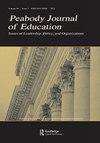Online Course-Taking and Expansion of Curricular Options in High Schools
Q2 Social Sciences
引用次数: 1
Abstract
ABSTRACT A common rationale for offering online courses in K-12 schools is that they allow students to take courses not offered at their schools; however, there has been little research on how online courses are used to expand curricular options when operating at scale. We assess the extent to which students and schools use online courses for this purpose by analyzing statewide, student-course level data from high school students in Florida, which has the largest virtual sector in the nation. We introduce a “novel course” framework to address this question. We define a virtual course as “novel” if it is only available to a student virtually, not face-to-face through their own home high school. We find that 7% of high school students in 2013–14 enrolled in novel online courses. Novel courses were more commonly used by higher-achieving students, in rural schools, and in schools with relatively few Advanced Placement/International Baccalaureate offerings.高中在线课程学习和课程选择的扩展
摘要在K-12学校开设在线课程的一个常见理由是,它们允许学生选修学校没有开设的课程;然而,关于在线课程在大规模运营时如何扩大课程选择的研究很少。我们通过分析佛罗里达州高中生的全州学生课程水平数据来评估学生和学校为此目的使用在线课程的程度,佛罗里达州拥有全国最大的虚拟部门。我们引入了一个“新颖的课程”框架来解决这个问题。我们将虚拟课程定义为“新颖”,如果它只对学生进行虚拟学习,而不是通过自己的家庭高中面对面学习。我们发现,2013-14年,7%的高中生参加了新颖的在线课程。在农村学校和高等教育/国际文凭课程相对较少的学校,成绩较高的学生更常使用新颖的课程。
本文章由计算机程序翻译,如有差异,请以英文原文为准。
求助全文
约1分钟内获得全文
求助全文
来源期刊

Peabody Journal of Education
Social Sciences-Education
CiteScore
2.20
自引率
0.00%
发文量
43
期刊介绍:
Peabody Journal of Education (PJE) publishes quarterly symposia in the broad area of education, including but not limited to topics related to formal institutions serving students in early childhood, pre-school, primary, elementary, intermediate, secondary, post-secondary, and tertiary education. The scope of the journal includes special kinds of educational institutions, such as those providing vocational training or the schooling for students with disabilities. PJE also welcomes manuscript submissions that concentrate on informal education dynamics, those outside the immediate framework of institutions, and education matters that are important to nations outside the United States.
 求助内容:
求助内容: 应助结果提醒方式:
应助结果提醒方式:


